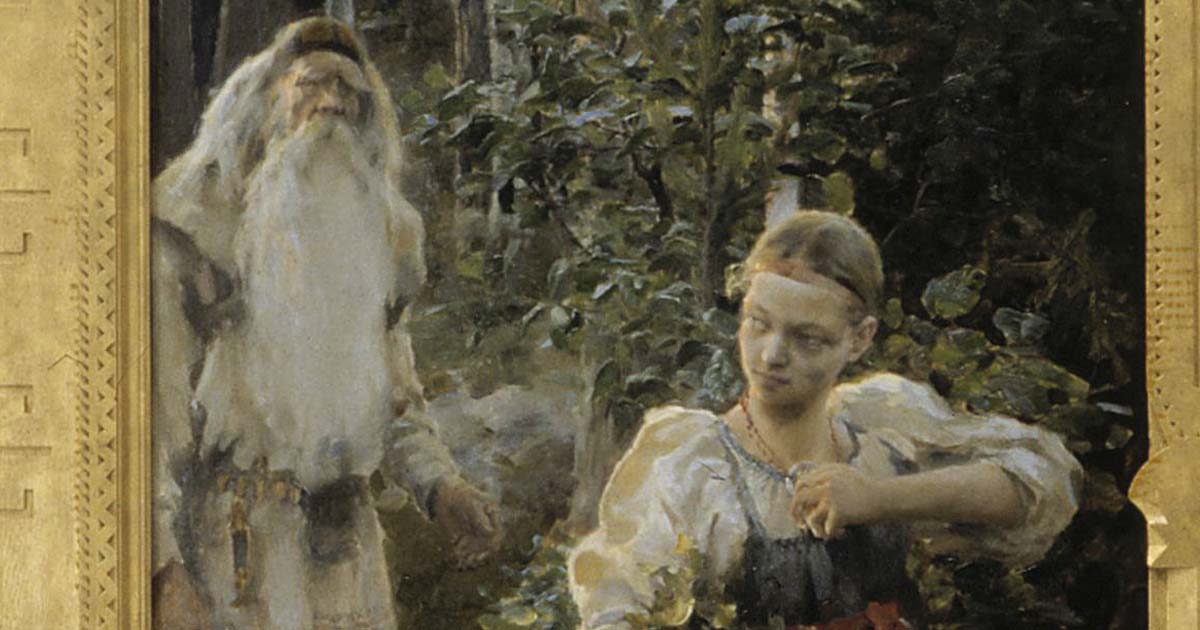Women of Kalevala –Aino, the tragic heroine
Kalevala, authored by Elias Lönnrot is one of the most famous and widely translated works in Finnish literature. Kalevala is the national epic of Finns and was written in the form of a mythological poem. Kalevala tells the mesmerizing stories of joys and miseries of the heroes of Kalevala, who themselves are not free from humanly weaknesses. Kalevala was a shattered epic, whose fragments were starting to disappear from among the local people, when Elias Lönnrot collected and compiled them all to create a beautiful and lively plot. Artists, writers, musicians, dancers, and actors from Finland and abroad have been inspired by this work. The preface of Kalevala was signed by Elias Lönnrot on 28 February 1835. Ever since, this day has been commemorated and celebrated as Kalevala day in Finland.
The language of Kalevala is based on the diverse and rich Karelian dialect of Finnish language. The tale of Kalevala chronicles the conflict and survival of the people of Kalevala and Pohjola. This fascinating story of magicians, heroes and shamans resembles a lot to the Indian epic Mahabharata. Today as we celebrate the International Women's Day, instead of writing about the brave and valiant heroes of Kalevala, I would prefer to pen the story of Aino, the tragic heroine of Kalevala who becomes a torment to every readers’ heart.
Aino! The only sister of the young warrior Joukahainen, and the only daughter of her aging parents. Elias Lönnrot named this young maiden, “Aino,” which means “only” or “single” in Finnish. Aino was a beautiful young maiden, who loved to spend her time roaming in the forests of Wäinölä, talking to her favorite lakes, flowers, and wild animals. It was then that Aino's overconfident and arrogant brother Joukahainen challenged the great scholar and main protagonist of Kalevala, Väinämöinen to a musical contest.
Joukahainen, who loses the spell singing contest with Väinämöinen sinks into a swamp by the latter’s magical power. Fearing death, he offered all his possessions to Väinämöinen, but Väinämöinen, who had no interest in material possessions, turns them down. Joukahainen promises to marry off his only sister Aino to the old and unmarried Väinämöinen. This promise pleases Väinämöinen, who has been searching for a bride for a long time and in turn he saves Joukahainen from drowning and dying in the swamp.
But Aino, who has not thought of marriage in her wildest dreams was shocked to hear the news. Unable to accept the forthcoming changes in her life, she expressed her unwillingness to leave her parents’ home to become old Vainamoinan's bride. On the other hand, Aino's mother is incredibly delighted to accept the ancient and wise Väinämöinen as her daughter’s husband and forces her to marry. Mother believes that marrying him would give Aino a secure future and tries to convince her daughter by showing the wedding dress and jewelry. Although Kalevala is a fictional story, it is evident from the tale of Aino that the social circumstances in ancient Finland was not very favorable for women and the women of that time had to face many obstacles to pursue their own likes and interests.
One day, Väinämöinen meets Aino unexpectedly at the lake shore and expresses his love for her by praising her exotic beauty. Extremely upset, Aino removes all her jewelry and throws them into the lake. She runs back home and pleads to her parents and brother to cancel the wedding, but all in vain. She sobbed day and night and her sighs echoed in the woods of Wäinölä for days.

Photo credit: https://reppuli.com/blogi/vain...
At last, she decides to leave her home, realizing that if she stayed there, she has no choice but to accept the old Väinämöinen as her husband. She dresses herself like a new bride, wearing an alluring silk attire with silver jewelry and braiding her hair with colorful ribbons. For three days she wandered through the woods of Wäinölä, singing songs about her pain and agony. On the third day, a tired and exhausted Aino rests in her favorite seashore, and happens to see the beautiful Vellamo maidens bathing in the sea. Aino takes off her clothes and voluntarily dives into the deep sea like a water goddess to join them. Aino, a girl with thousand dreams and hopes in her eyes merged herself in the infinity of that deep sea with a heavy heart filled with unfulfilled desires.
When heard about the tragic news of Aino’s death, her parents and brother wept bitterly and repented of their deeds. In the words of Elias Lönnrot, the mother who lost her daughter says.
"Listen, all ye mothers, listen,
Learn from me a tale of wisdom:
Never urge unwilling daughters
From the dwellings of their fathers,
To the bridegrooms that they love not,
Not as I, inhuman mother,
Drove away my lovely Aino,
Fairest daughter of the Northland. "
Aino's mother tells us with a broken heart that this is a lesson for all parents that you should never force your daughters for marriage against their will. The devastated mother cries for days and a river is formed of her tears.
It seems to me that Elias Lönnrot addressed the social problems faced by women and girls in Finland at that time and tried to bring awareness among the people through the characterization and portrayal of Aino. Led by the world's youngest prime minister Sanna Marin, Finland today is a country which offers safety and freedom for women. On this International Women's Day, I wish that women all over the world have access to all opportunities and freedom to make their own choices. Let there be no more Ainos with shattered dreams who are thrown drown in the deep sea, instead let them fly without boundaries to reach their dreams with colorful wings!
Happy International Women's Day!
Hyvää kansainvälistä naistenpäivää!
